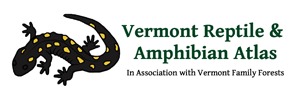Herp Update: Atlas in 2021, Vermont Almanac – December 16, 2021
Herp Atlas Progress in 2021
It is always fun at the end of another field season, to see how many new records we have added to our database. Over the past two weeks we have been finalizing and reviewing our 2021 reports.
This year we have added 2,434 new Vermont reptile and amphibian reports to our database. This is not counting reports of such things as amphibian crossing areas, snake dens, vernal pools, and turtle nesting areas. Six of these reports were non-native reptiles and amphibians (African Spurred Tortoise, Brown Anole, Mediterranean House Gecko-3, and Pond Slider). Two were Eastern Box Turtles, a species that might or might not be native to Vermont. Seventy-four reports were of species that are listed as threatened or Endangered in Vermont. Fifty-four were of species that are not listed, but are still rare in Vermont. Two hundred seventeen reports were of species that are considered unusual (S3) in Vermont. The remaining 2,080 reports were of more common species (S4 & S5). All these reports were carefully reviewed and contributors were contacted and thanked.
Of the reports of more common species, 91 filled in data gaps providing photos of species that either had never been photographed in a given town, or where photos needed to be updated. Twenty of these new town records were of Spring Salamanders. Although a couple of these were provided by volunteers, most were from our own efforts. We targeted Spring Salamanders this year since they are not often found or reported by volunteers and they are an indicator of cold, clean, well-oxygenated water. Thirteen of the new town records were Pickerel Frogs, 12 were Ring-necked Snakes, 9 were American Bullfrogs, and we had 8 new or updated town reports of both Spring Peepers and Gray Treefrogs. Almost all of these reports were from volunteers such as yourself.
On the other hand, the number of new town reports needed for American Toads, Eastern Red-backed Salamanders, and Northern Dusky Salamanders increased by 1. How is this possible? It occurs as reports become more than 25 years old and need to be updated. For example, if we filled in five town gaps for a species and four other town records for that species became historic, the number of gaps has increased by 1. These are usually very easy records to update. There are only two towns in Vermont where we need updated or first photos of Eastern Red-backed Salamanders (Braintree and Brunswick). An hour spent in mature hardwoods in either of those two towns turning logs and rocks should reveal an Eastern Red-backed Salamander. A photo could then be taken and sent to us, and those two towns will have been updated. I am hoping that next spring, you can help us update some of these records.
The Vermont Reptile and Amphibian Atlas Annual Fundraiser
As of this afternoon (Thursday), the Vermont Reptile and Amphibian Atlas fundraiser has passed the 2/3 mark with over $17,000 raised toward our goal of $25,000 for next year. Gifts have ranged in amount from $5 to $500 and all gifts are greatly appreciated. If you have not donated already, please donate. If you have donated already, thanks again. To learn more about what we have accomplished over the past year and to see the many ways you can contribute, please visit our GoFundMe site at:
Our upcoming course: Conserving Vermont’s Reptiles
There are only seven slots remaining in our Conserving Vermont’s Reptiles course scheduled for this winter (remote) and next spring (outdoors). For more information or to register visit either: https://www.eventbrite.com/e/conserving-vermonts-reptiles-tickets-211892103987 or https://familyforests.org/conserving-vermonts-reptiles/
Recent Press
The Vermont Reptile and Amphibian Atlas received some nice coverage in the recently-released Vermont Almanac, Volume 2. These are great books about rural life in Vermont. You might want to give one for a holiday gift.

